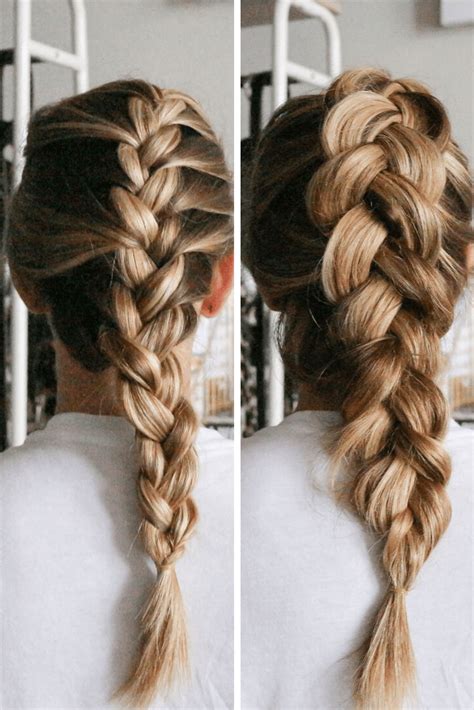Introduction

From the cobblestoned streets of Amsterdam to the chic avenues of Paris, two iconic braid styles have captivated hearts and adorned heads for centuries: the Dutch braid and the French braid. Both intricate and visually stunning, these braids offer a timeless elegance that transcends trends. But what are the key differences between these two braiding techniques? Which one is right for you? Embark on a hair-raising journey as we dissect the intricate details and unique characteristics of Dutch vs. French braids.
Historical Origins
-
Dutch Braid: Originating in the Netherlands, the Dutch braid (also known as the “inside-out” braid) first emerged in the 16th century. Its unique construction, where the strands are crossed over instead of under, gives it a distinctive raised and voluminous appearance.
-
French Braid: The French braid, a staple of French fashion and elegance, traces its roots back to the 18th century. This braid is created by crossing the strands under instead of over, resulting in a smooth, flat, and intricate design.
Key Differences
1. Braiding Direction:
– Dutch Braid: Crossed over (inside-out)
– French Braid: Crossed under
2. Volume and Appearance:
– Dutch Braid: Raised and voluminous
– French Braid: Flat and intricate
3. Suitability for Hair Types:
– Dutch Braid: Thick, coarse hair
– French Braid: All hair types
4. Complexity:
– Dutch Braid: More complex and challenging to learn
– French Braid: Easier to master
5. Visual Impact:
– Dutch Braid: Bold and eye-catching
– French Braid: Conservative and sophisticated
Which Braid Is Right for You?
The choice between a Dutch braid and a French braid ultimately depends on your hair type, desired look, and skill level.
-
For thick, coarse hair or a dramatic and voluminous style, the Dutch braid is an excellent option.
-
For all hair types, including fine or thin hair, the French braid provides a versatile and sophisticated choice.
Step-by-Step Guides
How to Dutch Braid
- Divide your hair into three equal sections.
- Cross the right section over the middle section.
- Take a thin strand of hair from the left and cross it over the new middle section (formerly the right section).
- Repeat steps 2-3, alternating sides, until you reach the end of your hair.
- Secure with a hair tie or bobby pins.
How to French Braid
- Divide your hair into three equal sections.
- Cross the right section under the middle section.
- Take a thin strand of hair from the left and cross it under the new middle section (formerly the right section).
- Repeat steps 2-3, alternating sides, until you reach the nape of your neck.
- Continue braiding as a traditional three-strand braid until you reach the end of your hair.
- Secure with a hair tie or bobby pins.
Creative Applications
Beyond their traditional uses, Dutch and French braids can be incorporated into various hairstyles to create stunning and versatile looks.
-
Half-Up Braids: Braid the top section of your hair and leave the rest down for a bohemian and effortless style.
-
Mermaid Braids: Combine multiple braids into a fishtail-inspired design for a captivating and unconventional look.
-
Braided Crowns: Braid your hair into a crown around your head for a regal and elegant hairstyle suitable for special occasions.
Useful Tables
Table 1: Dutch vs. French Braid Characteristics
| Feature | Dutch Braid | French Braid |
|---|---|---|
| Direction | Crossed over | Crossed under |
| Volume | Raised | Flat |
| Hair Type | Thick | All types |
| Complexity | More complex | Easier |
| Visual Impact | Bold | Conservative |
Table 2: Benefits of Dutch and French Braids
| Braid Style | Benefits |
|---|---|
| Dutch Braid | Voluminous, eye-catching, suitable for thick hair |
| French Braid | Versatile, sophisticated, suitable for all hair types |
Table 3: Hairstyle Ideas with Dutch and French Braids
| Hairstyle | Braid Type | Occasion |
|---|---|---|
| Half-Up Braid | Dutch or French | Casual, bohemian |
| Mermaid Braid | Combination of braids | Festival, special occasion |
| Braided Crown | Dutch or French | Formal, elegant |
Table 4: Step-by-Step Braid Guides
| Braid Style | Guide |
|---|---|
| Dutch Braid | Dutch Braid Tutorial |
| French Braid | French Braid Tutorial |
Conclusion
The Dutch braid and the French braid, two iconic and timeless braiding techniques, offer a myriad of versatile styling options. Whether you embrace the bold volume of the Dutch braid or prefer the classic sophistication of the French braid, both styles are sure to elevate your look and turn heads. Embrace the art of braiding and let your creativity soar as you master these intricate techniques. May your hair be adorned with the beauty and elegance that only a Dutch or French braid can provide.
